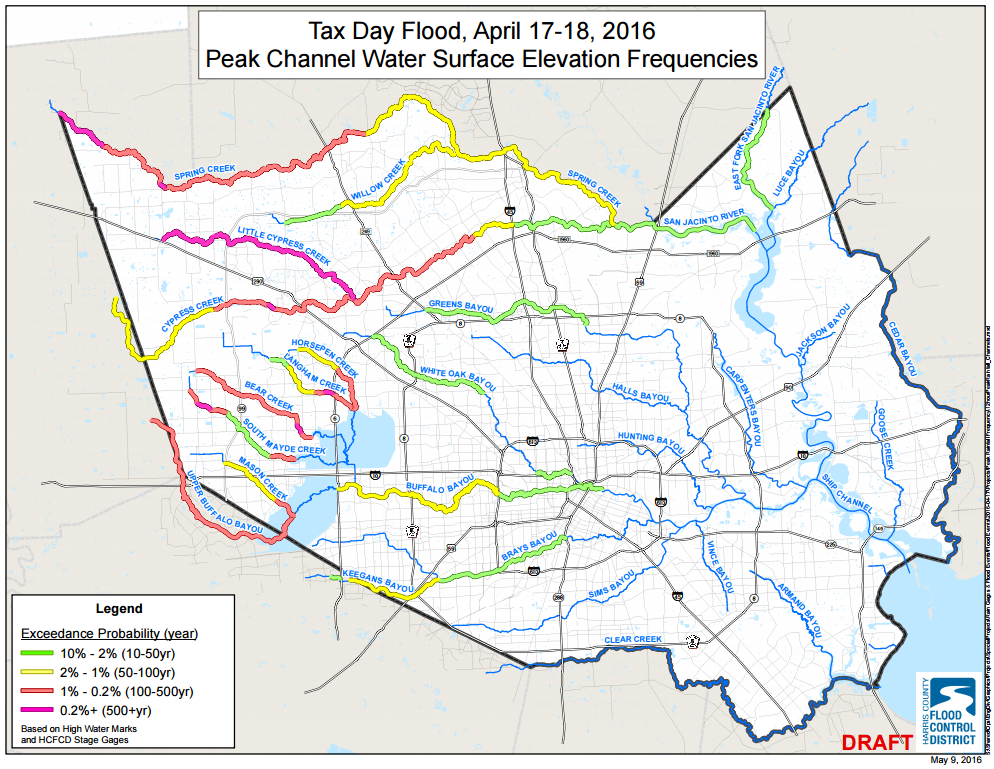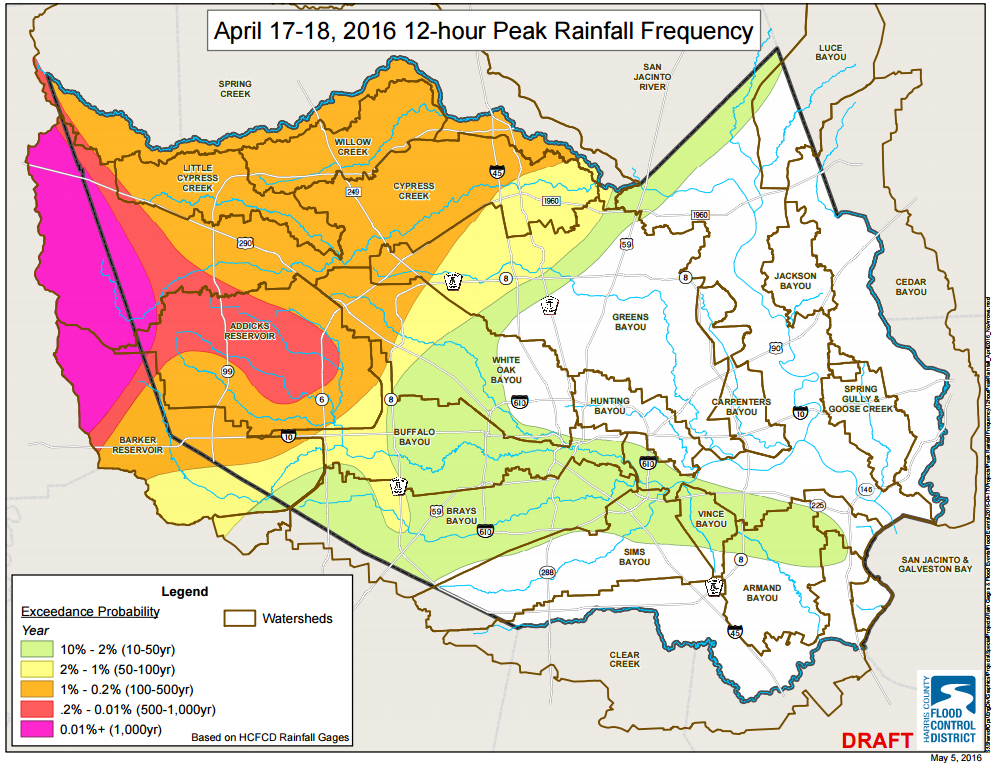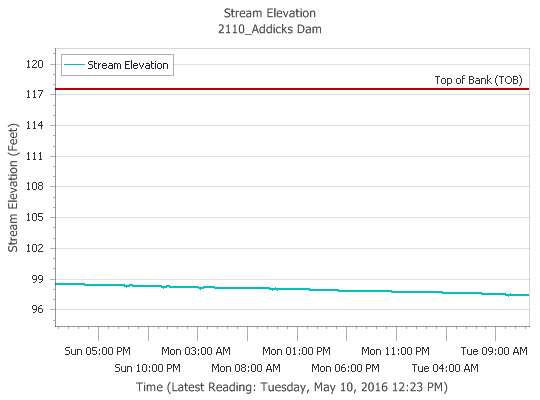The Harris County Flood Control District (HCFCD) has released their second report on the Tax Day Flood event last month. There isn’t anything shockingly new in this report, but it is an interesting read and brings the historic event into greater focus. I’ve scoured it and pulled a few interesting nuggets and images. (Note: For larger versions of the images just click on them.)

The total number of houses that flooded exceeded 7,000 in Harris County. Add in an additional 2,700 apartment units that flooded, plus 430 homes in Waller County, and you get over 10,000 households that experienced some form of flooding last month. That’s truly an incredible number.
HCFCD went out and found high water marks along many creeks and bayous in Harris County. They ended up compiling nearly 300 high water marks, which is the second largest effort they’ve undertaken (surpassed only by Hurricane Ike’s 476 high water marks in 2008).

Repairs and debris removal on area channels and detention basins since the flooding has cost north of $12.5 million so far. This includes slope failures, bank erosion, outfall pipe damage, and downed trees.
The real champions remain Addicks and Barker Reservoirs though. While there was flooding around those facilities and there continues to be flooding traffic headaches there, the amount of damage those two structures prevented from occurring as you approach downtown Houston is staggering. At one time on April 18th approximately 49,150 cubic feet of water were flowing into Addicks reservoir per second. That is equivalent to about 2.2 million gallons of water per minute being kept out of a flooding west Houston.

As of Tuesday afternoon, the Addicks Reservoir is at 97.4 feet, down from its peak of 102.65 feet after the rain. The good news is that once we hit 96 feet, that means water should be off Highway 6, meaning cleanup can begin. Of course, that will take some time, and TxDOT has stated that it will be at least until May 26th before Highway 6 can open.
We will continue to have more coverage of the Tax Day floods and their implications for the greater Houston region.
I am so thrilled to have “found” you now that you’re no longer at the Chronicle. Your postings are so informative and thorough.
Thanks for your tireless efforts!
Welcome, Brian!
I live along Brays Bayou and find it extremely troubling that a 10-50yr flood event is causing out of bank conditions and residential flooding. Future rainfalls of this magnitude are not uncommon and will certainly cause the same damage again and again. Re-starting the Brays Project will certainly help if funding is approved, but improvement would appear to be years away.
I agree with Gary. That being said, I know this is strictly about weather, but is it outside the scope to find some experts who can speak to what people in particular areas can do to help protect themselves outside of basics like sand bags? Like if we modify our homes, what would help minimize future damage? What can we as communities push and prod? #newbiehomeowner
Chris,
We’ll try to address some of those questions over the next few weeks.
Improvements are on the way. A contract to widen the bayou between the Medical Center to 2200ft. west of Buffalo Spwy will be let this month. This will be competed by late 2017 when the next phase from that point to South Rice will be up for bid. Followed by the last phase from South Rice to Fondren. By 2020 the project should be 100% completed.
Neighborhoods around Cypress Creek near Champions flooded for the 3rd time since 2001 (Allison 2001, Ike 2008, Tax Day 2016)–two “100 year” rain events and one “500 year” rain event, all within the past 15 years. What are the odds? As farm and forest are converted to subdivisions along the new section of the Grand Parkway in the coming years, the flooding will surely get worse.
If you look at the flood plain map (http://www.harriscountyfemt.org/) there is something very fishy about the line separating the 100 and 500 year flood plains. The line looks like it was drawn by politicians rather than following topographical contours. The Wimbledon Champions neighborhood, for example, smack dab at the confluence of Spring Gully and Cypress Creek, is magically drawn out of the 100-year flood plain–yet half of it flooded last month. Think it will be another 500 years before it floods again?
The problem will only worsen in the future. The increased development in western Harris County means that a 10 year rainfall event can result in a 100 year flooding event (notionally speaking). Twenty years ago, even a historic event such as the one experienced in April wouldn’t have been nearly as troublesome. Rain falling over undeveloped fields and prairies would have taken much longer to reach the streams. Today it falls on rooftops, parking lots and streets where it is directly channeled to the creeks and bayous, resulting in an immediate and significant rise in stream levels. I’m afraid this will become more commonplace in the future, especially given the rapid pace of development in the Cypress Creek watershed.
Not only that, the prevailing habit, at least in my neighborhood, is to run drains from gutters out to the street, so the rain from roofs is going straight into the storm sewers, and from there to the bayous.
I don’t always read about the weather but when I do…I read your daily emails. I know I’ll get a nice snippet of quality. Thanks for the hard work and keep having fun with it.
Thanks Dustin!
I don’t follow your math in the third to last paragraph:
49,150 cu ft/sec * 7.48 gal/cu ft * 3600 sec/hr = 1.323 billion gallons/hr
That’s because I meant per minute! Good catch, thanks.